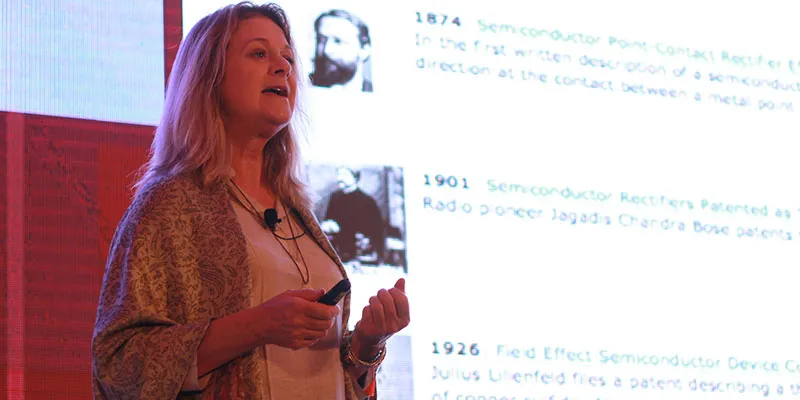When the world celebrated Indian entrepreneurship from TechSparks stage
Fifth edition of the annual startup extravaganza, TechSparks culminated with the grand finale taking place at The Leela Palace, Bangalore. A mindboggling array of sessions, provided a variety of perspectives, which kept over a 1000 attendees glued to their seats till late in the evening.
TechSparks now boasts of an illustrious alumni of over 100 startups including stars such as Little Eye Labs, Forus Health Care, Capillary Technologies and JustUnfollow among an array of companies that are worth $350 million collectively.

Shradha Sharma, founder of YourStory kicked off the event in style and pumped up the audience by sharing the belief, “East or West, India is the best. In everything, and startups are no exception.”
Nandan Nilekani received one of the warmest welcomes from the fully energized audience. Here’s how history was created at TechSparks and why the world celebrated the Indian entrepreneurship from its stage.
Complimentary skills + common values = successful global startup
Nandan Nilekani, cofounder of Infosys and former head of UIDAI, which developed Aadhar, the digital identity scheme, gave an insight into building global businesses out of India by taking his own experience as the cue. He emphasized that only when Infosys started thinking big was it able to achieve a faster run rate of growth. He said that the founding team should have complementary skills connected by common values.

This was the very reason Infosys founders stayed together for long whereas companies founded along with Infosys fell by the wayside due to differences of opinion among cofounders. He said that he wanted Aadhar to be a digital identity platform triggering innovation similar to Internet and GPS. Both GPS and Internet started out as military applications and found a variety of uses once they came into private domain. He concluded,
“Had I been 40 years younger, I would have been one among you today.”
Answering a question, Nandan revealed that he is working towards eradicating illiteracy in children by providing access to alphabetical and numerical skills for the musing technology. Read our report on Nandan’s keynote here.
Category creators are made of sterner stuff
Shailendra Singh, MD, Sequoia Capital – India, in his keynote at TechSparks, sprinkled his wisdom peppered with insights and data. He focused on category creators or path makers, who always found it difficult to find acceptance and traction in their initial years. They had to stay in the hunt for long to get to the spotlight area. Quoting examples of Mu Sigma and Pine Labs to show that the paths they tread were unlike companies that just copied the established business models.

He also focused upon Practo, which has a unique business model, and Zomato, which created a category by itself. He repeated the benefits of taking the first principles (original thinking) approach. He emphasized on amplified communication when you are building something new. He highlighted the burden of positioning that trail blazers have to go through. He provided inspiration stating that most traditional industry sectors can be transformed using technology at the centre. He gave the example of Tesla, which redefined the automobile industry using technology.
You are the brand ambassador of your product
Given his stardom at twitter, it is likely that many of the followers of Ramesh Srivats, founder of TenTenTen, are not aware his branding expert avatar. He had the audience in splits by taking a dig at the social media by saying Twitter is like a short miniskirt (hot, short, and controversial), Facebook is like a Lycra swimsuit (always yearning for likes), and Google+ is like a pyjama (you can be relaxed here).What people fail to find in social media is people. Instead they focus on brands, which leads to clutter. To stand out, he provided the following pointers:
- Use your product as your message
- Use your customers as your media
- Use your employees as your salesmen
- Use yourself as the brand ambassador
He concluded by saying, be yourself, be interesting (being educative and informative) and be friendly.

First your local market and then the Southeast Asian market
Takeshi Ebihara, Founding GP, Redbright Partners, gave the audience a peek into the Southeast Asian market for product entrepreneurs. He contended that getting into a new geography is always challenging, but the startup should find traction in the local market before expanding outward. He cited the example of Zomato, which first captured the Indian market before taking a slice of the Southeast Asian market. Singapore is the financial capital of APEC market where you can find venture money, while Indonesia and Thailand provide user markets. Instead of getting into the APEC market to get over local competition, he asked product entrepreneurs to venture in if they are the first movers. For Internet ads, Indonesia is a hot market and e-commerce and mobile apps do well in Thailand as Internet penetration is high here. He felt that APEC as a single entity is a large market, calling it United States of Southeast Asia, but the individual domestic markets are small.
Xiaomi is planning a manufacturing centre in India
The smiling Manu Jain, India Head of Xiaomi, was not intimated by a question on whether some reports on Indian user information getting into Chinese servers bothered him. He provided a matter-of-fact reply stating Xiaomi as a Chinese company has servers in China. He repeatedly stressed that Xiaomi is a startup in India and conceded that the company underestimated the demand in the Indian market. They had planned only for 10,000 mobile handsets in a week and today they are selling 100,000 a week. This has prompted Xiaomi to think of a manufacturing centre in India.

He gave a detailed account of how Xiaomi connects with fan clubs and spends zero money on marketing by just selling handsets online. He said that Xiaomi started out as a mobile technology company developing Android software but when it felt that it could be able to achieve better results by having a compatible hardware as well, the company got into mobile handsets business. He also said that a core team in India is working on how to better connect to fan clubs and how to do things differently. He provided an insight into what made Xioami successful: the company put thrust both on product and process innovation. He answered questions on Me themes and Me business mascots as well.
Silicon Valley cannot be replicated but its traits can be
Ellen PetryLeanse, former alumnus of Google and Apple, who flew all the way to TechSparks form the Valley, combined philosophy with reality to give out a right outlook for product entrepreneurs. Being in the Silicon Valley, she provided an insight into how the Valley works. She said, “Silicon Valley cannot be replicated.” She explained that innovators exist all over the world. Silicon Valley blends several elements of an open culture that fosters innovation like an open mind to encourage failure, encouraging experimentation, and readiness to share information. “Think different,” she urged the audience, using our own Mahatma Gandhi as an example. The focus should be on understanding the problems and providing solutions, she said. She used the example of latest brain research to drive home her point of innovation involving several “heads.” She alluded to increasing the use of art in design thinking, placing empathy as a trait to develop products.

It was all but a satisfying day for entrepreneurs who flocked TechSparks. They got a taste of several geographies apart from innovations in India. Stay tuned for more updates.
Here is the list of top 30 technology companies that showcased at TechSparks. For complete Techsparks coverage, click on #tsparks







